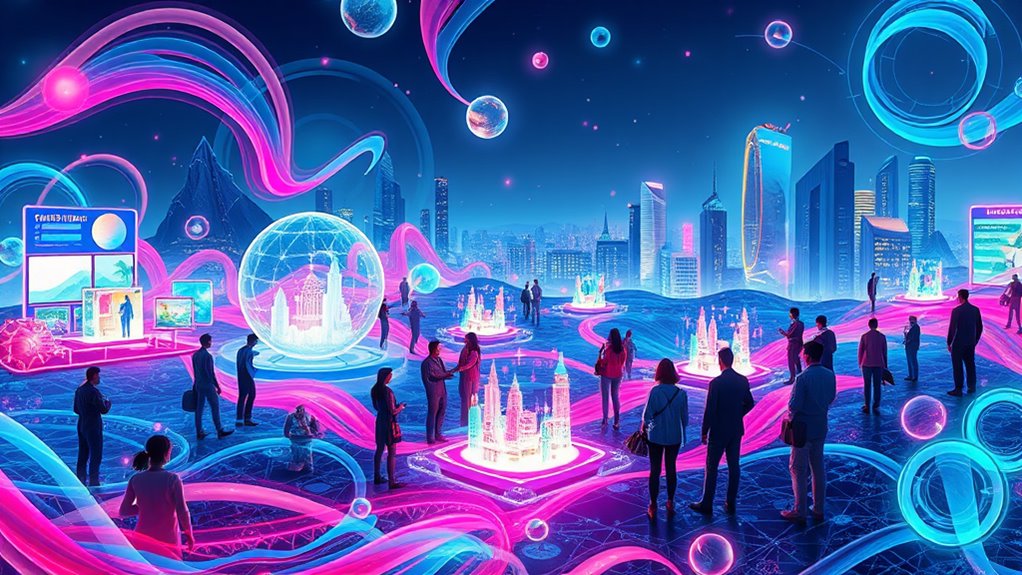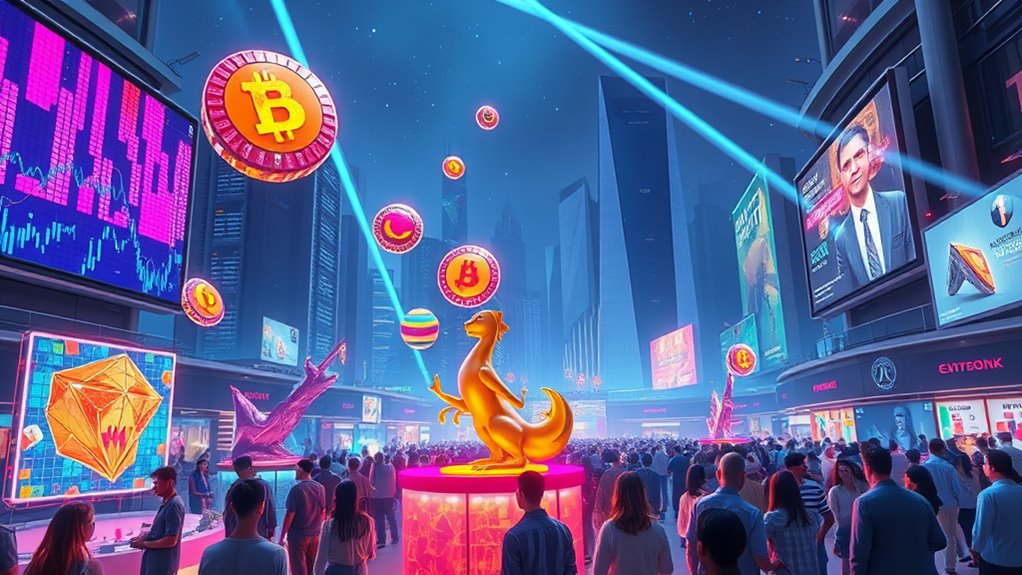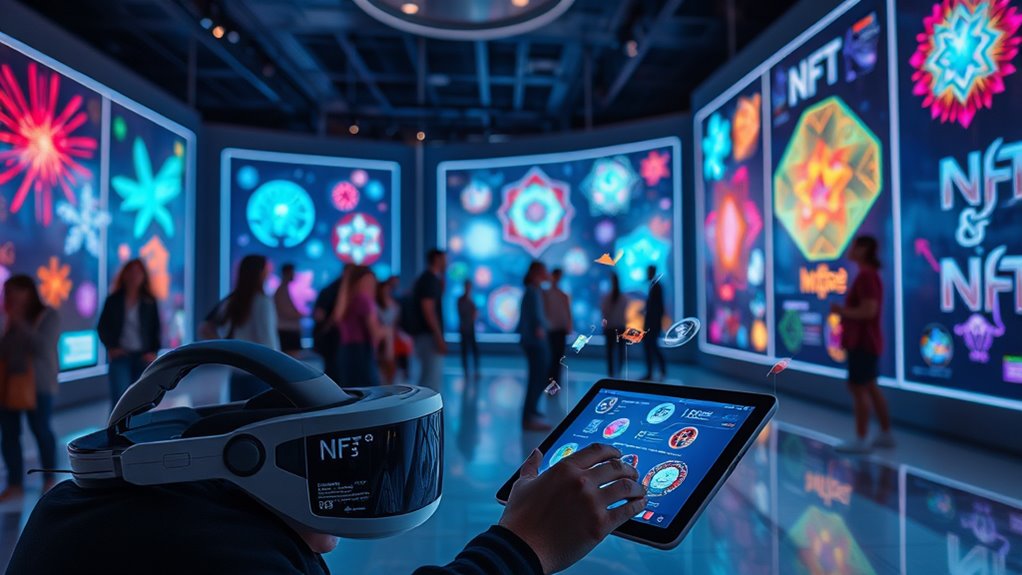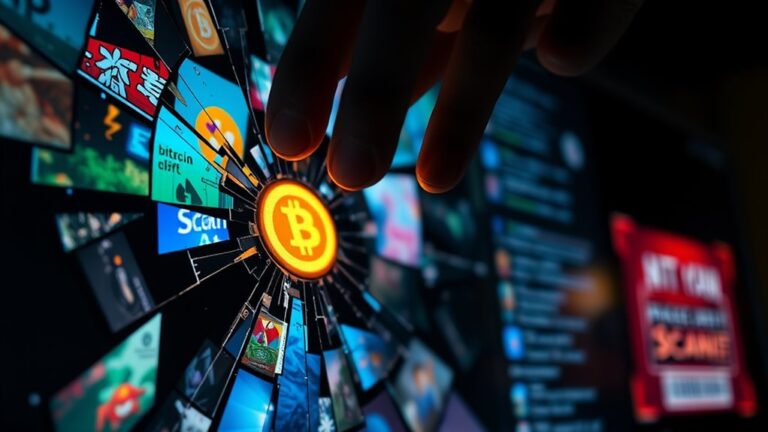
NFT Trends and Predictions: What to Expect in 2025
By 2025, the NFT market is expected to grow considerably, projected to reach $61 billion. Applications will expand beyond art and collectibles to include real estate, gaming, and supply chain management. Key drivers for this growth include advancements in blockchain technology, regulatory clarity, and a shift towards utility-driven uses. Additionally, innovations like dynamic NFTs and interoperability across platforms will enhance user engagement and investment opportunities. To understand the implications of these trends, further exploration is essential.
Key Takeaways
- The NFT market is projected to grow to $61 billion in 2025, driven by increased utility and adoption across various sectors.
- A shift from speculative trading to utility-driven applications is expected, enhancing the value of NFTs in gaming and real-world asset tokenization.
- Major brands are likely to explore NFT integration, promoting mainstream acceptance and creating new investment opportunities in unique digital assets.
- Improved blockchain technology and smart contracts will enhance security and efficiency, fostering trust and user engagement in the NFT ecosystem.
- Regulatory clarity regarding copyright and ownership will shape market stability, influencing how NFTs are created, bought, and sold in 2025.
Evolving Applications of NFTs

As the landscape of technology continues to evolve, the applications of non-fungible tokens (NFTs) are expanding considerably across various sectors.
In real estate, NFTs facilitate fractional ownership, allowing multiple investors to share property. This innovation streamlines management processes and enhances liquidity in traditionally illiquid markets.
Similarly, commodities like precious metals are being tokenized into NFTs, making them more accessible to investors. The integration of smart contracts also automates transactions, reducing the need for intermediaries.
Commodities like precious metals are being tokenized into NFTs, enhancing accessibility and automating transactions through smart contracts.
In addition, hybrid NFTs are emerging, combining digital assets with physical items, thereby increasing their value. As the metaverse expands, ownership of virtual land NFTs presents new opportunities for investment and community engagement.
These evolving applications suggest that NFTs could reveal significant market opportunities, transforming industries and enhancing user experience in the coming years.
Key Drivers Behind NFT Growth

The growth of non-fungible tokens (NFTs) can be attributed to several key drivers that enhance their appeal and usage across various sectors. These factors include technological advancements, cultural relevance, and economic conditions.
| Key Driver | Description |
|---|---|
| Unique Ownership and Security | Blockchain guarantees authenticity and secure ownership verification. |
| New Opportunities for Creators | Creators can sell directly to buyers, retaining more control and revenue. |
| Digital Collectibles and Culture | NFTs align with trends in gaming and entertainment, fostering community. |
| Economic and Market Factors | Increased crypto popularity and market trends influence NFT values. |
| Technological Innovation | Improved platforms and regulatory clarity enhance user experience. |
These drivers collectively contribute to the growing interest and investment in NFTs across diverse sectors. Additionally, the rise of utility-driven NFTs is expected to attract more users by offering exclusive rewards and governance rights.
Predictions for NFT Market Dynamics in 2025

Predictions for the NFT market dynamics in 2025 indicate a considerable shift as the industry matures and adapts to new trends and technologies.
By mid-2025, weekly trading volumes are expected to stabilize between $200 million and $300 million, reflecting a move from speculative trading to utility-driven applications. The integration of NFTs into various sectors, including gaming and real-world asset tokenization, is anticipated to enhance their value. Additionally, the rise of music NFTs is likely to empower artists and foster deeper connections with fans, reshaping the music industry landscape.
Major companies, such as Amazon and Salesforce, are entering the space, promoting mainstream acceptance. However, regulatory challenges, particularly concerning copyright and ownership, may influence market stability.
Impact of NFTs on Various Industries

The impact of NFTs on various industries is becoming increasingly significant, particularly in music, real estate, and gaming.
In the music industry, artists are finding new ways to monetize their work through NFT sales, allowing fans to own unique pieces of music.
Meanwhile, in real estate, NFTs are changing how ownership is recorded and transferred, while gaming experiences are enhanced by providing players with true ownership of in-game assets through blockchain technology. Furthermore, NFTs are also enhancing product authenticity in supply chain management, ensuring that consumers can trust the origin and quality of their purchases.
Music Industry Evolution
As artists seek new ways to connect with their audiences and generate revenue, the introduction of NFTs has markedly transformed the music industry.
NFTs enable musicians to sell their work directly to fans, bypassing traditional distribution channels. This direct sales model not only creates alternative revenue streams but also guarantees ownership and authenticity, protecting against piracy. Unique and exclusive music NFTs often attract fans willing to pay a premium.
Moreover, artists can earn ongoing royalties from resold NFTs, establishing a long-term income source. By embracing NFTs, musicians can explore innovative digital art forms and build token-gated communities, enhancing fan engagement and artistic independence. The integration of NFT royalties ensures that creators receive compensation even after their work has been resold, promoting a sustainable ecosystem for artists.
Real Estate Ownership Changes
NFTs are beginning to influence the real estate market in ways that could reshape ownership models and transaction practices. By 2025, forecasts suggest that 20% of real estate transactions may involve NFTs, enabling fractional ownership and making investments more accessible.
This technology reduces the need for intermediaries, enhancing transparency and efficiency in transactions. In addition, blockchain integration guarantees secure ownership records, decreasing fraud risks.
Smart contracts are expected to automate processes, increasing trust among investors. Moreover, tokenization allows for cross-border transactions, drawing in international investors. As the metaverse expands, its integration with cryptocurrency transactions will further revolutionize the real estate landscape.
Gaming Experience Enhancement
With the rise of blockchain technology, a notable transformation is occurring in the gaming industry as new possibilities emerge for enhancing player experiences. NFTs are revolutionizing gameplay by providing true ownership of in-game assets, allowing players to buy, sell, or trade independently. This fosters a play-to-earn (P2E) model, where players gain real-world value from their gameplay. Additionally, blockchain technology enhances security and reduces fraud risks. As traditional studios adopt these innovations, the gaming landscape is evolving. The table below summarizes key aspects of NFTs in gaming:
| Aspect | Description | Impact |
|---|---|---|
| Ownership | Players own in-game assets | Increases player investment |
| Economic Models | Introduces P2E and trading opportunities | Attracts a wider player base |
| Interoperability | NFTs usable across different platforms | Enhances player engagement |
Moreover, this shift is fostering strong community networks among players, as they collaborate and trade in P2E games.
Technological Innovations Shaping the Future of NFTs

Technological innovations are reshaping the landscape of NFTs, driving advancements that enhance their security, efficiency, and overall user experience.
As the NFT ecosystem evolves, several key developments are emerging:
- Blockchain Advancements: Continuous improvements in blockchain technology enhance the security and efficiency of NFT transactions, ensuring safer exchanges.
- Dynamic NFTs: These NFTs can change over time based on user interactions or external factors, opening new possibilities in art and gaming. Their ability to utilize smart contracts to update metadata automatically is revolutionizing how NFTs can be perceived and interacted with.
- AI Integration: Artificial intelligence is being utilized to improve authenticity and valuation, ultimately enhancing the user experience through smarter analytics.
These innovations signify a shift towards a more interactive and secure NFT landscape, broadening the potential applications and appeal of non-fungible tokens across various sectors.
Investment Opportunities and Market Projections

What factors are driving interest in investment opportunities within the NFT market?
The NFT market exhibits significant growth potential, projected to rise to $61 billion in 2025 from $43 billion in 2024. Investors are diversifying their portfolios, focusing on sectors such as art, gaming, and real estate. Notable projects like Bored Ape Yacht Club attract attention due to their established market presence.
Despite market volatility, NFTs are increasingly recognized as a stable asset class for long-term investment. The shift towards NFTs with utility and long-term value, alongside trends like hybrid tokens and real-world asset tokenization, further enhances their appeal. Additionally, major brands experimenting with NFTs in niches may create new opportunities for investors seeking unique digital assets.
Frequently Asked Questions
How Do NFTS Differ From Traditional Digital Assets?
NFTs differ from traditional digital assets primarily through their non-fungibility, unique ownership representation, and reliance on blockchain technology for security and authenticity, whereas traditional assets often lack these distinctive characteristics and qualities of ownership.
What Are the Environmental Concerns Surrounding NFTS?
In a world where one might expect a knight’s joust, the environmental concerns surrounding NFTs include significant energy consumption, high carbon emissions, and reliance on non-renewable resources, prompting calls for sustainable practices and renewable energy usage.
Can NFTS Provide Passive Income Opportunities?
NFTs can indeed provide passive income opportunities through mechanisms like staking, rentals, and royalties. By locking NFTs, lending them, or earning royalties from sales, owners can generate revenue while contributing to broader blockchain ecosystems.
How Are NFTS Regulated in Different Countries?
Regulated like a delicate ecosystem, NFTs face varying treatments worldwide. In the U.S., scrutiny intensifies; Europe introduces extensive frameworks; while Asia balances innovation with caution, illustrating the complex tapestry of global NFT regulations.
What Are the Risks Associated With Investing in NFTS?
Investing in NFTs carries risks such as high market volatility, unpredictable values, potential scams, and environmental concerns. Additionally, evolving regulations may create legal uncertainties, making NFT investments a challenging endeavor for many individuals.
Conclusion
To sum up, the NFT landscape is poised for significant change by 2025, influenced by evolving technologies and expanding applications. An important statistic is that the NFT market is projected to reach a value of $80 billion by 2025, highlighting its growing importance. As industries continue to adopt NFTs, understanding their dynamics will be essential for investors and consumers alike. The future holds numerous opportunities, underscoring the need for ongoing observation and adaptation within this rapidly changing market.












